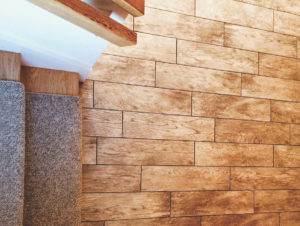If you are considering renovating your worn wood floor, upgrading from vinyl, or installing flooring in a new home, you might have seen something new since the last time you considered flooring: wood-look ceramic or porcelain plank tiles. Each tile bears an image — scanned from real wood — printed on it. The quality of that image, the size of the tiles, and the variation in any given shipment of the tile will affect how much these tiles look like real wood.

We asked Jeremy Selin, a contractor from Orleans who has installed many Outer Cape floors, to tell readers more about this popular option for floors.
Q: We think of tile floors as the right choice for bathrooms and kitchens, but why would a home owner install wood-look tile instead of real wood flooring in their living room or other areas of the house?
JS: Wood is prone to expanding and contracting as a result of changes in humidity and temperature. Even when the flooring is installed properly, you can get cupping in the wood that will look like humps or dips in your floor. This can be an issue in homes near the water, where doors are left open during humid summer weather, and especially in houses that are closed down over the winter. A first floor over a crawl space is an especially challenging environment for hardwood.
And while hardwood tends to get beat up, especially in high traffic areas of your home, tile is a durable, hard surface that is easy to clean and won’t get scratched or damaged, for example, by pets. Spills are also not an issue on tile.
Q: How do the costs compare? Installing tile can be expensive.
JS: The pandemic has brought about shortages in wood materials, and so wood is actually more expensive than other flooring options right now. By the time you have purchased the wood, had it installed, sanded, and finished, your hardwood floor might well cost more than tile. And the tile is a product that will never need to be refinished.
Wood-look tile comes in a range of prices. You can expect those made with excellent image processing to cost more. And since the tiles tend to be fairly large, they can take less time to install — in general, the smaller the tiles, the longer it takes to do an installation, which makes the job cost more.
Q: You make the tile sound like an attractive choice. What are the cons?
JS: Well, one of the drawbacks to any tile flooring is, of course, that it makes for a very hard substrate. Standing for long periods on it can be wearing. Tile also can feel cold on your feet, so those are factors to consider. We often install a heating mat under the tile, which works well and feels warm. It is important to remember, though, that these kinds of systems are for comfort only. It doesn’t heat the rest of the room.
Q: What if home owners would like to try to install a plank tile floor themselves? Is this a doable project if you are not a professional
JS: Installing a tile floor is backbreaking work, and it means spending a lot of time on your knees, too. It also takes patience. It’s not a one, two, three and done kind of project. I recommend doing research first, not jumping right in. There are many good videos out there on installing different kinds of tile flooring. Most plank tiles are all the same length, so if you want to mimic the look of a wood floor as closely as possible, you must install them using a random pattern. I also recommend choosing grout lines that are no smaller than 1/16 inch, preferably 1/8 inch, and using a leveling system.
I always encourage home owners who are enthusiastic about doing a project themselves. If you want to learn and are up for hard work, it’s absolutely possible.



